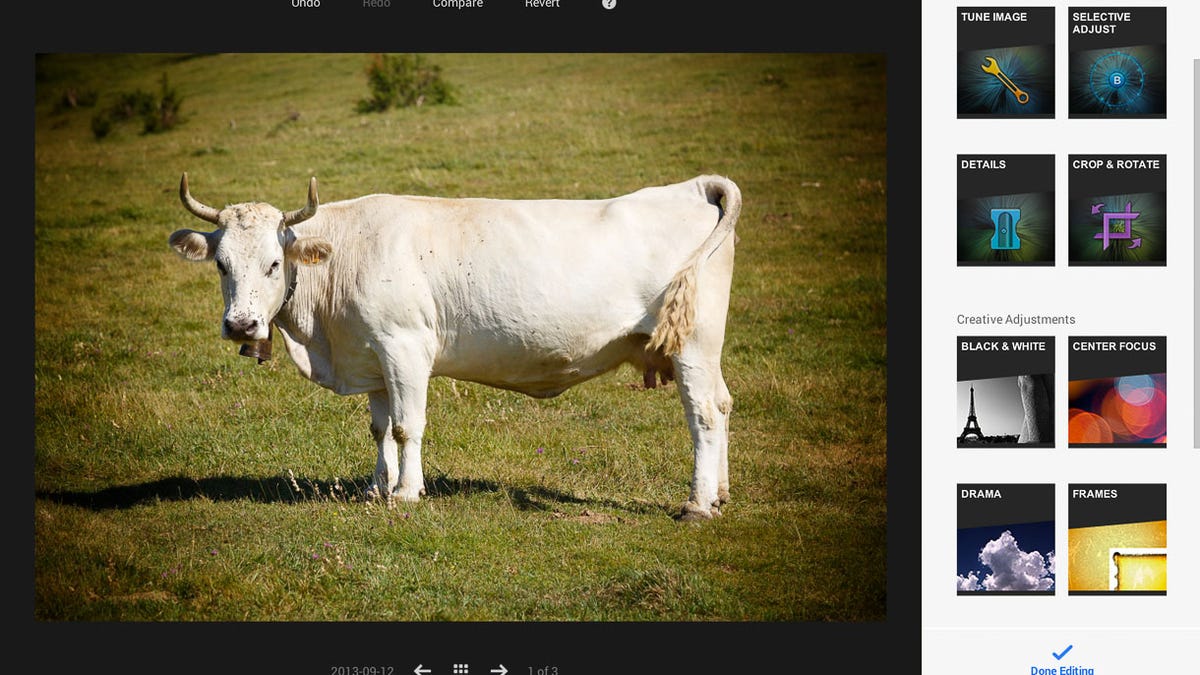Google+ gets sophisticated array of photo editing tools
Now we know what Google's Nik Software acquisition was really about: bringing respectable photo editing to cloud computing. But it's only for the Chrome browser.

With an update to Google+, Google has transformed online photo editing from a technology that's mostly ignorable to one that's genuinely useful.
Google has built its Snapseed photo-editing technology into Google+, and it adds an impressively wide range of sophisticated, customizable, easy-to-use adjustments to the service.
The company has been steadily improving Google+ photo tools in recent months, for example with the "auto awesome" features for enhancing photos and automatically constructing animations out of sequences of similar photos. But the newest photo editing changes, which Google+ photos product manager Josh Haftel announced Wednesday night, are a huge advancement.
The new tools open up a wide range of fine-tuning possibilities for the sort of person who might use consumer photo-editing tools like iPhoto or Photoshop Elements. You can tweak Google's auto-enhance editing choices, edit the entire photo or selected parts of it, and apply a number of highly customizable filter effects.
This sophisticated online editing option is only available in Chrome, though, since it uses Google's Native Client technology that other browser makers so far have shunned. Native Client (NaCl) lets programmers bring C and C++ software to the browser, something that's chiefly been of interest to game developers so far, but evidently Google put it to good use with the Snapseed editing software it got with its acquisition of Snapseed developer Nik Software.
As with photo editing on smartphones, where newcomers like Instagram carved out a market faster than established powers like Adobe Systems, photo editing online has the potential to elevate new players. Google is of course one such player in online editing, but there are others, too, such as Pics.io, which handles images in awkward but powerful raw formats and which just raised angel funding and opened its doors to testers. Where Google uses Native Client, Pics.io uses the WebGL standard supported by multiple browsers for its processing engine.
Photo editing with the new tools includes common photo-editing controls for settings like brightness, contrast, color warmth, and shadow recovery. That's ordinary enough, but the tools work well. You can crop and rotate shots, including the ability to use preset aspect ratios and a horizon-leveling tool.
Things get fancier quickly. A "details" section lets you fiddle with "structure," a local-contrast adjustment that seems similar to Adobe Lightroom's clarity adjustment. It can add a subtle pop or, pushed further, give a photo some of the surreal gritty look of HDR (high-dynamic range) styling.
Next up are the highly regarded control points that Nik Software invented for editing specific parts of a photo. You drop down a dot by clicking on the part of the photo you want to adjust. New dots appear next to the location dot; dragging left or right on each of them with your mouse will increase or decrease brightness, contrast, color saturation, and the size of the region that control point's changes affect. It's complicated to describe but easy to use and fairly flexible.
I found the tools responsive, even on pretty large 22-megapixel shots from my SLR. However, you can't zoom in like you can in the regular Google+ photo view, something that's limiting in some cases, such as trying set the right amount of sharpening without introducing artifacts.
When making editing changes, the changes show live on the image; you have to click an "apply" button for the changes to take. If you don't like your editing, you can revert the photo back to its original.
Clicking around to experiment with new looks is a good way to use the customizable filters.
These days, I groan each time I see Yet Another Filter Effect Tool arrive: for all their popularity, filter effects are the most overdone feature in photography these days. The Google+ filters, though, go well beyond Instagram with a huge range of customization.
The Vintage filter, for example, comes with 12 different color-shifting schemes, four sliders, and an option to blur the photo's periphery. The Retrolux filter lets you specify exactly how strongly the simulated light leaks are affecting the simulated film in your simulated camera. The range of options here for degrading your photos are impressive, though, and for those who like the effects, they're very well done and easy to use.
The tilt-shift tool is pretty good, too, letting you adjust the angle of the effect and details of how the blurring is applied. You also can pick frames -- a variety or straightforward black or white borders as well as some film and print effects for those who miss the good old analog era. Black-and-white options will appeal to the fine-art photo crowd who want the moodiness of high contrast and film grain, but if you want to go further, you can use virtual color filters that darken anything red, for example.
Last, Google+ now gives you the ability to customize its auto-enhance settings. It's a nice way to get started if you want a fairly sophisticated algorithm to give you a head start but think it's going too far or not far enough.
All in all, it's a great collection of tools, presented well. It's not up to the level of state-of-the-art tools like Lightroom, but it's very good for those who want to refine their photos.

